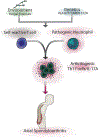CARD9 in the pathogenesis of axial spondyloarthritis
- PMID: 38897880
- PMCID: PMC11534080
- DOI: 10.1016/j.berh.2024.101964
CARD9 in the pathogenesis of axial spondyloarthritis
Abstract
Axial spondyloarthritis (axSpA) has been long classified as an autoimmune disease caused by a breakdown in the ability of the immune system to delineate self from foreign, resulting in self-reactive T cells. The strong genetic association of HLA-B27 supports this role for T cells. More recently, genetic and clinical studies indicate a prominent role of the environment in triggering axSpA, including an important role for microbes and the innate immune response. As an example, mutations in genes associated with innate immunity, including the anti-fungal signaling molecule Caspase recruitment domain-containing protein 9 (CARD9), have been linked to axSpA susceptibility. Thus, current thought classifies axSpA as a "mixed pattern condition" caused by both autoimmune and autoinflammatory mechanisms. The goal of this review is to convey.
Keywords: Ankylosing spondylitis; Axial spondyloarthritis; CARD9 protein; Neutrophils; Spondyloarthritis.
Published by Elsevier Ltd.
Conflict of interest statement
Declaration of competing interest There are no conflict of interest for co-authors AS, HS, LC, or RN.
Figures



References
Publication types
MeSH terms
Substances
Grants and funding
LinkOut - more resources
Full Text Sources
Research Materials

